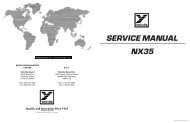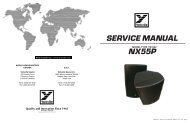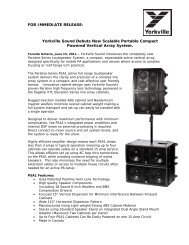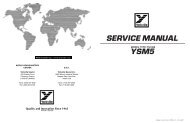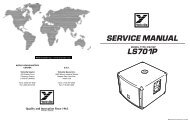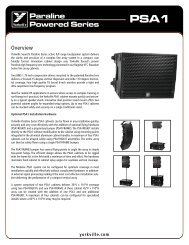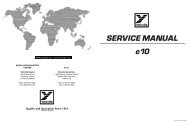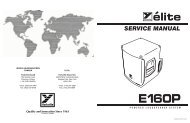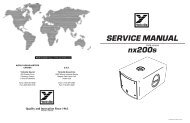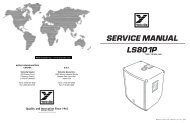owner's manual manuel de l'utilisateur - Yorkville Sound
owner's manual manuel de l'utilisateur - Yorkville Sound
owner's manual manuel de l'utilisateur - Yorkville Sound
You also want an ePaper? Increase the reach of your titles
YUMPU automatically turns print PDFs into web optimized ePapers that Google loves.
The MAIN fa<strong>de</strong>rs also <strong>de</strong>termine the signal levels <strong>de</strong>stined for the EQ/AMP ASSIGNbutton where they are directed as follows:a) Up in the L&R position, the ASSIGN button directs the Left & Right MAINmaster signals to EQ1 and EQ2 respectively. Thereafter they go in two directionsat once - to the L&R inputs of the built-in power amplifier and to theL&R POST EQ LINE OUTPUT jacks.b) Down in the MAIN/MON position, the ASSIGN button also does two things.First, it sums some of the LEFT and RIGHT MAIN signals into a single monosignal and directs it to the input of EQ1, the output of which is then split andgoes to both the LEFT power amp channel and to the POST EQ MAIN (L)LINE OUTPUT jack. Secondly, the button takes some of the MON MASTER’soutput signal and routes it to the input of EQ2, thereafter to be split and routedto the RIGHT channel of the built in power amplifier and to the POST EQMON (R) LINE OUTPUT jack.User tip: The stereo operating mo<strong>de</strong> of the AP312 would be with the EQ/AMPASSIGN button up in the L&R position. This would supply up to 320 watts of stereopower (160 watts/channel) plus separate L&R 9-band EQ’s for the main system speakers.Power and equalization for the monitors would come from a separate poweramplifier and graphic EQ. With the EQ/AMP ASSIGN button down in the MAIN/MON position, you now have 160 watts of mono power @ 8 Ohms plus a single 9-band EQ for the main PA speakers, also 160 watts @ 8 Ohms and a single 9-band EQfor the monitors. Connect main PA speakers to the AMP 1 SPEAKEROUTPUT’s andmonitors to AMP 2 SPEAKER OUTPUTS. See un<strong>de</strong>r SPEAKER CON-NECTIONS forsuggested speaker impedances.Pre & Post EQ Line OutputsThese are the outputs of the L&R main mixing busses. They are all at line level (donot connect speakers directly) and unbalanced. The PRE EQ outputs are not affectedby either of the graphic equalizers. The stereo main mix is available from them at alltimes, regardless of the EQ/AMP ASSIGN button setting. These would be availablefor connecting a secondary mixer perhaps for a house PA, broadcast and/or recordingpurposes. These outputs,although not balanced, havebeen <strong>de</strong>signed to supply thenoise-canceling benefits ofbalanced outputs as long asthe inputs of the unit (poweramp or mixer) you are connectingthem to have balancedinputs, and you useTRS balanced cablesThe POST EQ outputsignals are affected by the graphic equalizers. They are also affected by the EQ/AMPASSIGN button. With the button up in the L&R MAIN position, these jacks receivethe output of EQ1 at the L MAIN jack and EQ2 at the R MON jack. With the EQ/AMPASSIGN button down in the MAIN/MON position, the L MAIN jack receives mono(left & right mixed together) main mix signal from EQ1 and monitor signals from EQ2.The POST EQ outputs are best for driving power amplifiers whether for main or monitorspeaker systems.EQ1 & EQ2 Graphic EqualizersThese are 9-band EQs having standard ISO octave-spaced frequencies. The Q-factoris greater in cut-mo<strong>de</strong> than in boost-mo<strong>de</strong>, which is <strong>de</strong>sirable when using the EQfor feedback control. Up to 12dB of cut or boost is available. For more informationabout their internal routing, see un<strong>de</strong>r LEFT & RIGHT MAIN MASTERS and EQ/AMPASSIGN BUTTON above.6User tip: As with all graphic EQ’s, minimal variations above or below center settingsare always recommen<strong>de</strong>d. The only exception to this rule might be in the fight againstfeedback, but even there the i<strong>de</strong>al solution is to separate the offending speaker from theoffending mic or at least aim them in different directions. This way the whole system’s



